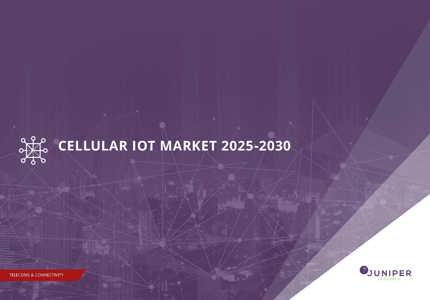An Interview With Thales Part 2
We interviewed their team to find our more about their award-winning cellular IoT solution, and how it can help operators secure their IoT connections.
1. Analysts expect a drastic growth of connected objects, and among them, a number will be connected to cellular networks. Can you tell me what’s in it for MNOs?
Indeed, we expect huge growth for IoT in both the consumer and industrial domains such as automotive, healthcare, smart cities, infrastructure, track and trace and more.
The emergence of this new ecosystem represents many commercial opportunities for MNOs (Mobile Network Operators), who can deliver exciting new IoT use cases, quickly and efficiently.
Moreover, there can be no doubt that the emergence of new-generation 5G networks will help enable explosive growth in the number of devices connected both to people and each other, which will consequently boost commercial opportunities for MNOs.
Trust and security must be built in, along with the potential to scale effectively to keep pace with rapid growth.
However, there are security challenges, when we talk about security sensitive services, such as smart metering, smart energy, industry 4.0 and healthcare with health monitoring. For those types of services, security is a must-have indeed.
2. More precisely, what are the security challenges?
MNOs have a key role to play in the development of IoT with cellular connectivity and especially for security.
The IoT is characterised by fragmentation in terms of the OS (Operating System) employed. There are several open source and proprietary IoT OSs already on the market. Given the variety of applications, hardware and connectivity encompassed with IoT, it is likely that the market will continue to sustain multiple OSs for the foreseeable future. In this respect, any IoT security implementation which is dependent on the type of OS cannot be scaled and is not sustainable. This is a key security challenge that MNOs need to address.
Establishing trust and confidence in the IoT is a priority for all stakeholders looking to benefit from the new age in connectivity. Essentially, the security framework must fulfil three key requirements: mutual authentication between IoT device and cloud, the integrity and confidentiality of security-sensitive data both at rest and in motion, and last but not least, the scalability of security and cost effectiveness, as the IoT is a cost-sensitive market.
3. Do MNOs need new technology to enable scalable IoT security?
Not at all. There is an existing technology/framework, which is already proven in the field and is ideally suited for the IoT: secure elements at large and, more specifically, eSIM/SIM in the case of cellular connectivity for IoT. Indeed, secure elements can deliver scalable ‘security-by-design’ for IoT, while eSIM/SIM can deliver scalable IoT security for cellular networks.
The approach is to leverage those hardware-based, tamper-proof elements, which are already present in every single cellular device, also known as the Root of Trust, to store sensitive data such as keys and security services. Moreover, secure elements are standard technology and are ideally suited to integrate the GSMA’s latest IoT SAFE (IoT on-SIM Applet For Secure End-2-End Communication) specifications.
The GSMA’s IoT SAFE specifications provide an interoperable and scalable security framework for IoT. We are the first to implement the GSMA standard specifications for IoT. This is an unprecedented advancement in terms of scalable IoT security for all security-sensitive use cases.
4. What is your offer for MNOs to achieve scalable and sustainable security for IoT in a cost-effective manner?
The issue is how the device’s middleware can leverage the security services in a scalable manner. And this is the problem Thales IoT SAFE, implementing the GSMA IoT SAFE specifications, solves: to specify and standardise an API so the device’s middleware can use the credentials and security services in the secure element (SIM, eSIM, eSE) in a standard manner; all parties can now talk the same language.
Thales can address the challenge of securely and efficiently connecting IoT devices to the cloud through cellular networks, thereby offering demonstrable benefits for all key stakeholders. Thales enables the opportunity to leverage assets that include widely deployed and field proven cellular networks and secure element-based security solutions that store credentials, to deliver services that can be enhanced to address IoT security in an interoperable environment defined by GSMA standards. Thales’ comprehensive IoT SAFE Service enables the secure end-to-end connection between the cloud and devices in the field, and is a proven and resilient gateway to the fast-growing IoT market.
IoT SAFE GSMA standard is cost-effective, as it leverages the SIM/eSIM which is present in every single cellular device. There is no need to add and pay for an additional secure element.
5. What are the benefits of Thales IoT SAFE and particularly for MNOs?
To start with, Thales delivers IoT SAFE as a service, it is plug and play without any integration effort required for all the stakeholders in this ecosystem. Those stakeholders are:
- Mobile network/telecoms operators – providing the connectivity that embraces not only billions of people, but also billions of devices.
- Service providers – developing applications for clouds and devices.
- Cloud providers – hosting and managing IoT applications.
- Device makers – building IoT devices or producing the components that are at the heart of IoT devices.
In an interoperable framework, cloud providers can offer secure and seamless access, while minimising the risk of attacks to their domain. OEMs and chipset makers can: protect device integrity, streamline the production of secure devices, and overcome fragmentation. Service providers can develop secure services once, then deploy everywhere, regardless of device fragmentation. In addition to this, those in charge of the management and maintenance of IoT devices can benefit from remote ‘zero touch’ connectivity and management of connected devices across many diverse locations in the field. Costly and time-consuming site visits by employees to maintain IoT devices are replaced by swift, real-time, over-the-air updates managed by MNOs.
6. Moving forward, how do you think the roles of MNOs will evolve?
MNOs are uniquely positioned to drive cellular IoT. Around the world, they manage billions of deployed SIMs and eSIMs. MNOs therefore have unrivalled experience and capabilities to meet the challenges of a vast IoT ecosystem, in which these secure elements represent the Root of Trust. In addition to this, MNOs are already engaged in verifying and digitising their subscribers ID at enrolment. They are ideally positioned to enrol and link trusted digital IDs of objects with trusted digital IDs of their owners: MNOs can become Trusted Digital ID providers for people and things. In this role, MNOs will be further supported by key enabling technologies for the digital transformation, such as the 5G framework, online ID verification and eSIM (embedded SIM) technology.
Finally, MNOs have such a global reach that their impact on digital transformation across the world could be exceptional.
Latest research, whitepapers & press releases
-
 ReportDecember 2025
ReportDecember 2025AI Agents for Customer Experience Platforms Market: 2025-2030
Our comprehensive AI Agents for Customer Experience Platforms research suite comprises detailed assessment of a market that is set to disrupt mobile communications. It provides stakeholders with insight into the key opportunities within the AI agents for customer experience platforms market over the next two years.
VIEW -
 ReportDecember 2025Fintech & Payments
ReportDecember 2025Fintech & PaymentseCommerce Fraud Prevention Market: 2025-2030
Our eCommerce Fraud Prevention research suite provides a detailed and insightful analysis of this evolving market; enabling stakeholders from financial institutions, law enforcement agencies, regulatory bodies and technology vendors to understand future growth, key trends, and the competitive environment.
VIEW -
 ReportNovember 2025Telecoms & Connectivity
ReportNovember 2025Telecoms & ConnectivityeSIMs & iSIMs Market: 2025-2030
Juniper Research’s eSIMs and iSIMs research suite offers insightful analysis of a market set to experience significant growth in the next five years. The research suite provides mobile network operators (MNOs), original equipment manufacturers (OEMs), and eSIM management and platforms vendors with intelligence on how to capitalise on the market growth, and guidance on how eSIM-only devices and sensors, SGP.42, in-factory provisioning, and iSIMs will change the competitive landscape.
VIEW -
 ReportNovember 2025Fintech & Payments
ReportNovember 2025Fintech & PaymentsModern Card Issuing Platforms Market: 2025-2030
Our Modern Card Issuing Platforms Market research suite provides a detailed and insightful analysis of this evolving market; enabling stakeholders from banks, financial institutions, fintech companies, and technology vendors to understand future growth, key trends, and the competitive environment.
VIEW -
 ReportNovember 2025Fintech & Payments
ReportNovember 2025Fintech & PaymentsDigital Wallets Market: 2025-2030
Our digital wallets research suite provides detailed analysis of this rapidly changing market; allowing digital wallet providers to gain an understanding of key payment trends and challenges, potential growth opportunities, and the competitive environment.
VIEW -
 ReportOctober 2025Fintech & Payments
ReportOctober 2025Fintech & PaymentsDigital Identity Market: 2025-2030
Juniper Research’s Digital Identity research suite provides a comprehensive and insightful analysis of this market; enabling stakeholders, including digital identity platform providers, digital identity verification providers, government agencies, banks, and many others, to understand future growth, key trends, and the competitive environment.
VIEW
-
 WhitepaperDecember 2025Telecoms & Connectivity
WhitepaperDecember 2025Telecoms & ConnectivityHuman + AI: Drivers of Customer Experience AI Agents in 2026
Our complimentary whitepaper, Human + AI: Drivers of Customer Experience AI Agents in 2026, examines the key drivers of the AI agents for customer experience platforms market in 2025.
VIEW -
 WhitepaperDecember 2025Fintech & Payments
WhitepaperDecember 2025Fintech & PaymentsBeyond Chargebacks: The True Cost of Fraud for Digital Commerce
Our complimentary whitepaper, Beyond Chargebacks: The True Cost of Fraud for Digital Commerce, examines the state of the eCommerce fraud prevention market; considering the impact of evolving digital fraud strategies, including key trends such as identity theft, account takeovers, chargebacks, policy abuse and friendly fraud.
VIEW -
 WhitepaperNovember 2025Telecoms & Connectivity
WhitepaperNovember 2025Telecoms & ConnectivityeSIM-only Devices: The Impact on Operators, Consumers, and IoT
Our complimentary whitepaper, eSIM-only Devices: The Impact on Operators, Consumers, and IoT, explores the challenges and opportunities for the three segments, with a particular focus on eSIM-only smartphones and SGP.42.
VIEW -
 WhitepaperNovember 2025Fintech & Payments
WhitepaperNovember 2025Fintech & PaymentsUnlocking the Next Stage of Growth for Modern Card Issuing Platforms
This free whitepaper analyses key trends shaping the modern card issuing space, and the ways in which modern card issuing platforms can capture growth.
VIEW -
 WhitepaperNovember 2025Fintech & Payments
WhitepaperNovember 2025Fintech & PaymentsTop 10 Fintech & Payments Trends 2026
Fintech is evolving fast. From stablecoins to agentic AI, our annual guide reveals the shifts redefining payments, digital identity, and the future of money in 2026. Download your copy today.
VIEW -
 WhitepaperNovember 2025Fintech & Payments
WhitepaperNovember 2025Fintech & PaymentsDigital Wallets: Empowering Financial Inclusivity
Our complimentary whitepaper, Digital Wallets: Empowering Financial Inclusivity, examines the state of the digital wallets market; considering the impact of digital wallets on different geographies, how they are shaping the modern payments landscape through lower transaction fees and promoting financial inclusivity for underbanked populations, and how they are competing with established payment methods.
VIEW
-
IoT & Emerging Technology
Juniper Research Unveils Top 10 Emerging Tech Trends to Watch in 2026
January 2026 -
Fintech & Payments
Digital Identity App Usage to Hit 6.2 Billion by 2030, Driven by Shift to Decentralised Models
December 2025 -
Telecoms & Connectivity
Travel eSIM Margins Under Pressure as Revenue per Gigabyte Falls 10% Globally in Two Years
December 2025 -
Telecoms & Connectivity
AI Agents to Power 1,000% More Customer Interactions for Enterprises Globally by 2027
December 2025 -
IoT & Emerging Technology
Global D2C Revenue Set for $370 Million Surge, But Satellite Operators Should Not Chase Full MNO Status
December 2025 -
Fintech & Payments
Digital Goods Fraud to Cost eCommerce Merchants $27 Billion Globally by 2030 as AI Tools Accelerate Attacks
December 2025





















